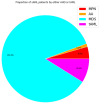Recent Advances towards the Understanding of Secondary Acute Myeloid Leukemia Progression
- PMID: 38541635
- PMCID: PMC10971423
- DOI: 10.3390/life14030309
Recent Advances towards the Understanding of Secondary Acute Myeloid Leukemia Progression
Abstract
Secondary acute myeloid leukemia (sAML) is a heterogeneous malignant hematopoietic disease that arises either from an antecedent hematologic disorder (AHD) including myelodysplastic syndromes (MDS), myeloproliferative neoplasms (MPN), aplastic anemia (AA), or as a result of exposure to genotoxic chemotherapeutic agents or radiotherapy (therapy related AML, tAML). sAML is diagnosed when the number of blasts is ≥20% in the bone marrow or peripheral blood, and it is characterized by poor prognosis, resistance to therapy and low overall survival rate. With the recent advances in next generation sequencing technologies, our understanding of the molecular events associated with sAML evolution has significantly increased and opened new perspectives for the development of novel therapies. The genetic aberrations that are associated with sAML affect genes involved in processes such as splicing, chromatin modification and genome integrity. Moreover, non-coding RNAs' emerged as an important contributing factor to leukemogenesis. For decades, the standard treatment for secondary AML has been the 7 + 3 regimen of cytarabine and daunorubicin which prolongs survival for several months, but modifications in either dosage or delivery has significantly extended that time. Apart from traditional chemotherapy, hematopoietic stem cell transplantation, CAR-T cell therapy and small molecule inhibitors have also emerged to treat sAML.
Keywords: 7 + 3 regimen; AHD; AlloSCT; CAR-T; HSC; LSC; MDS; MPN; sAML; tAML.
Conflict of interest statement
The authors declare no conflict of interest.
Figures




Similar articles
-
Epidemiology and Clinical Significance of Secondary and Therapy-Related Acute Myeloid Leukemia: A National Population-Based Cohort Study.J Clin Oncol. 2015 Nov 1;33(31):3641-9. doi: 10.1200/JCO.2014.60.0890. Epub 2015 Aug 24. J Clin Oncol. 2015. PMID: 26304885
-
Secondary Acute Myeloid Leukemia (sAML): Similarly Dismal Outcomes of AML After an Antecedent Hematologic Disorder and Therapy Related AML.Clin Lymphoma Myeloma Leuk. 2022 Apr;22(4):e233-e240. doi: 10.1016/j.clml.2021.09.019. Epub 2021 Oct 1. Clin Lymphoma Myeloma Leuk. 2022. PMID: 34756570
-
Treatment patterns and outcomes of 2310 patients with secondary acute myeloid leukemia: a PETHEMA registry study.Blood Adv. 2022 Feb 22;6(4):1278-1295. doi: 10.1182/bloodadvances.2021005335. Blood Adv. 2022. PMID: 34794172 Free PMC article. Clinical Trial.
-
In Pursuit of Genetic Prognostic Factors and Treatment Approaches in Secondary Acute Myeloid Leukemia-A Narrative Review of Current Knowledge.J Clin Med. 2022 Jul 23;11(15):4283. doi: 10.3390/jcm11154283. J Clin Med. 2022. PMID: 35893374 Free PMC article. Review.
-
Challenges in the diagnosis and treatment of secondary acute myeloid leukemia.Crit Rev Oncol Hematol. 2019 Jun;138:6-13. doi: 10.1016/j.critrevonc.2019.03.003. Epub 2019 Mar 16. Crit Rev Oncol Hematol. 2019. PMID: 31092386 Review.
Cited by
-
Acute Myeloid Leukemia in Older Patients: From New Biological Insights to Targeted Therapies.Curr Oncol. 2024 Oct 24;31(11):6632-6658. doi: 10.3390/curroncol31110490. Curr Oncol. 2024. PMID: 39590121 Free PMC article. Review.
-
Genetic landscape of cancer: mechanisms, key genes, and therapeutic implications.Clin Transl Oncol. 2025 Aug 17. doi: 10.1007/s12094-025-04019-4. Online ahead of print. Clin Transl Oncol. 2025. PMID: 40820071 Review.
-
Menin Inhibitors: New Targeted Therapies for Specific Genetic Subtypes of Difficult-to-Treat Acute Leukemias.Cancers (Basel). 2025 Jan 4;17(1):142. doi: 10.3390/cancers17010142. Cancers (Basel). 2025. PMID: 39796769 Free PMC article. Review.
References
Publication types
LinkOut - more resources
Full Text Sources
Research Materials
Miscellaneous

